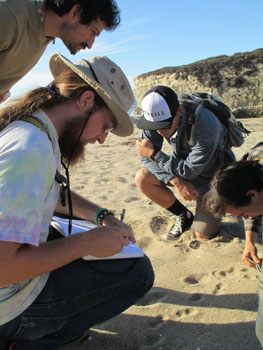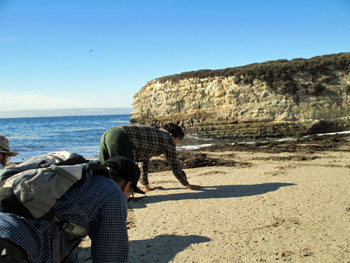J.T. Beggs scampered across the sand on his hands and knees, imitating the trot of a coyote.
Behind him, a group of UC Santa Cruz students and alumni mirrored his movements in what looked like an odd game of tag, but was actually an experiment to see if they could experience what it felt like to be coyote moving purposefully across a beach in the dark quiet of an autumn night.
The exercise was part of a unique Animal Tracking class hosted by UCSC’s Office of Physical Education, Recreation and Sports. Like many of the OPERS classes which are designed to expand the college experience, this one was aimed not only at connecting students more closely with nature but also to their human roots and even the origins of science.
Beggs, a shaggy-haired musician and expert tracker, stood at the end of a narrow ocean cove as the class began. “A skilled tracker has the same kind of questioning mind as a scientist,” he told students. A tracker looks at evidence, asks questions, then goes back to tell stories of his or her discoveries and adventures — just as a researcher might.
Moving to a line of prints he would later identify as belonging to a mature female bobcat that was traveling slowly from a seaside trail to the beach, Beggs said tracks tell more of a story than simply what animal made them. “A good tracker can tell what kind of species they are seeing. They can tell whether the animal is male or female, what the animal is eating, whether it is traveling during the day or at night, and what mood it’s in — whether it’s frightened or comfortable or feels safe.”
The students nodded their heads. This is what many of them came to learn about. But the class, held on a crisp fall morning, was more than a lecture about telling a raccoon trail from that of a meandering skunk. It was a primal, Sherlock Holmesian adventure that included folklore, visualization, and even music.
For instance, Beggs, who grew up wandering Santa Cruz’s open spaces and also teaches at Headwaters Outdoors School, led students through a rhythmic exploration of a raccoon’s gait, clapping for each print he found in the sand as if they were a musical score. The staggered steps soon created a beat that suggested a calm deliberation as the raccoon moved to a freshwater pond to drink.
“Look at Western music,” Beggs told the students, “the beat often relates to cultures who were pastoral or were horseback riders.”
Finding another line of tracks near the ocean’s edge, Beggs stopped. “This gait is interesting,” he said.
He urged students to imagine an animal the size of a housecat. “Picture this animal doing a meandering shuffle, cantering around the beach in a snaking pattern,” Beggs said.
“It’s a skunk,” said T.K. Kim (Crown, environmental studies, 2013), who later described the class as “awesome.”
“Right,” Beggs said. “Skunks love beaches. They love rooting in the seaweed for all those little invertebrates.” Again, he clapped out the beat of the animal’s paw prints. “Can you hear it moving?” he asked.
Students closed their eyes and dug through the sand as if they were raccoons in search of food. They sniffed the ground like coyotes and asked themselves questions about the tracks they found until they came to a conclusion about the animal’s story. They told stories of raccoons at Crown College, of golden eagles they spotted in the Great Meadow.
“Tracking can be the headiest, most complicated thing but it can also be a felt expression of the animal,” Beggs said. “Both ways can take you into a deep connection with the animal.”
The class — which was started in 1997 by Chris Lay (Crown, 1995, math), now a lecturer at UCSC and curator of the university’s Museum of Natural History — is a way to open students’ eyes to a world that may be hidden in the rush of modern life.
“It’s like a lost language,” Lay said of tracks that tell stories of animals mating, hunting, and playing. “People don’t even know they can read it.”
“This is working with the oldest blueprint of human hunting and gathering,” said Robin Bliss-Wagner (Kresge, bioregional studies, 2006), a longtime teacher of the class and an expert tracker who studied with Jon Young and the Kalahari Bushmen of Botswana. “This is the language of nature.”
Dominic Digloria (College 9, environmental studies, 2013) said he was surprised — and glad — to find himself digging through the sand with eyes closed and clapping out a skunky rhythm.
“This was more than I expected,” he said of the class. “It definitely provided another level of understanding.”
“It’s really awesome,” said Dan Hoffman (Merrill, chemistry, 2017) who grew up in Manhattan Beach and came to the class because he wanted to know more about the natural life around him. “It has been such a great experience to get in touch with nature, to get in touch with the animals.”




